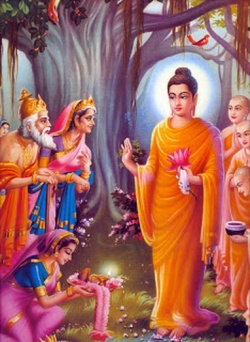Three groups of voice-hearers
three groups of voice-hearers
三周の声聞 (Jpn sanshu-no-shomon )
Also, three groups of voice-hearer disciples. Shakyamuni's voice-hearer disciples, whose enlightenment is prophesied in the theoretical teaching (first half) of the Lotus Sutra. There, Shakyamuni teaches that the sole purpose of the Buddha's advent is to expound the one Buddha vehicle, or the teaching that leads all people to Buddhahood. He explains that the three vehicles, or the teachings directed at voice-hearers, cause-awakened ones, and bodhisattvas, set forth in earlier sutras, are not ends in themselves but only means to lead people to the supreme vehicle of Buddhahood. This concept is called the "replacement of the three vehicles with the one vehicle." Shakyamuni Buddha's disciples are divided into three groups according to their capacity to understand that teaching: those of superior, intermediate, and inferior capacity. This traditional division of capacity was employed by T'ient'ai (538-597) and others in interpreting the Lotus Sutra.
A description of the three groups follows.
(1) Voice-hearers of superior capacity: Shariputra. He alone understands the above concept immediately upon hearing the Buddha preach concerning "the true aspect of all phenomena" in the "Expedient Means" (second) chapter. The "Simile and Parable" (third) chapter predicts his enlightenment.
(2) Voice-hearers of intermediate capacity: Maudgalyayana, Katyayana, Mahakashyapa, and Subhuti. They understand the Buddha's message through the parable of the three carts and the burning house related in the "Simile and Parable" chapter. Their enlightenment is predicted in the "Bestowal of Prophecy" (sixth) chapter.
(3) Voice-hearers of inferior capacity: Purna, Ananda, Rahula, and others. They finally understand the Buddha's message by hearing about their relationship with Shakyamuni beginning major world system dust particle kalpas in the past, as explained in the "Parable of the Phantom City" (seventh) chapter. Purna's enlightenment and that of twelve hundred arhats are prophesied in the "Five Hundred Disciples" (eighth) chapter, and the enlightenment of Ananda and Rahula and two thousand voice-hearers, in the "Prophecies" (ninth) chapter.
Thus, the cycle of Shakyamuni's preaching, the disciples' understanding, and Shakyamuni's prediction of their enlightenment is repeated three times and is accordingly called the three cycles of preaching. Those who received the prophecy of enlightenment through the three cycles of the Buddha's preaching are called the three groups of voice-hearers.
